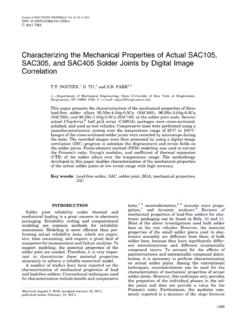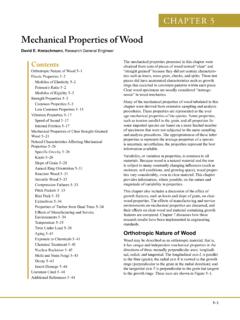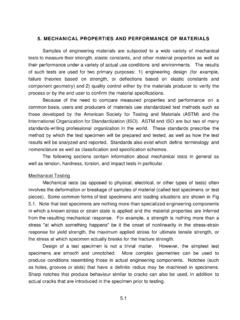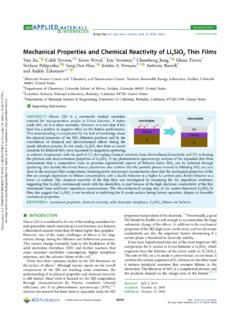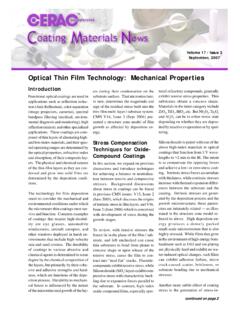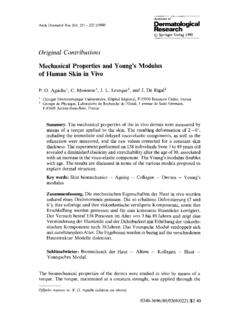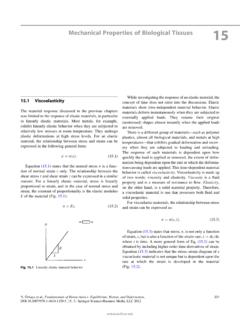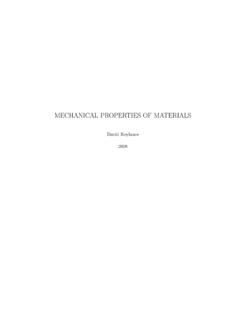Transcription of Literature review by Irene Chen - University of California ...
1 Literature review byIrene chen Skin Skin functionalities / Skin anatomy mechanical properties of skin Basic properties of collagen and elastin Viscoelastic properties of skin Viscous and elastic spring constants Finite element modeling of skin deformation Skin mechanical properties measuring devices Suction and torsion devices Skin mechanical failure Hypertrophic scar tissue Stretch mark tissue Tissue engineering Animal skin mechanics Rhinoceros and eel skin material properties Muscle tissue: skeletal muscle, cardiac muscle, and smooth muscle Hierarchical organization of skeletal muscle Hills functional model Cardiac mechanics mechanical properties of smooth muscle Heaviest single organ of the body (16% of total body weight) m2of surface area contacting external environment Skin on the back is 4mm thick and scalp skin is thick 3 major layers: epidermis, dermis, and hypodermis layer Epidermis layer s mechanism- prevent water loss, thermal control, and UV protection Skin is heterogeneous, anisotropic and a non-linear viscoelastic materialRoss, Michael.
2 Histology: A text and Atlas. Pensylvania: Wojciech Pawlina, Keratinocyte: are structural protein components, they play a role in forming the epidermal wall barrier Langerhans : are antigen-producing cells in the epidermis layer Melanocyte: produces melanin (pigments in skin) Merkel s cell: cells in the epidermis layer which relates to sensory in skinRoss, Michael. Histology: A text and Atlas. Pensylvania: Wojciech Pawlina, 2003. A proteoglycanmatrix Collagen fibers (type I and type III): are responsible for mechanical properties of skin Elastic fibers: giving elasticity of skin Blood vessels: providing oxygen and nutrients Nervous system : having sensory purposeRoss, Michael.
3 Histology: A text and Atlas. Pensylvania: Wojciech Pawlina, 2003. Depends on the nature and organization of: Dermal collagen and elastic fibers network Water, proteins and macromolecule embedded in the extracellular matrix with less contribution by epidermis and stratum corneumAgacheP, mechanical properties and Young s modulus of human skin in vivo , Arch DermatolRes 1980: 269: 221-232 300 nm long and nm in diameter Tropocollagentriple helix- consist of three polypeptide strands Quaternary structure (stabilized by hydrogen bonds) 29 types of collagen E along fiber ~ 1000 MPa UTS ~ 50-100 , , Biomechanics.
4 mechanical properties of living tissue 2nded. Springer( 1993) Collagen I: skin, tendon, vascular, ligature, organs, bone (main component of bone) Collagen II: cartilage (main component of cartilage) Collagen III: reticulate (main component of reticular fibers), commonly found alongside type I. Collagen IV: basis of cell basement membranes Collagen V: Cells surfaces, hair and placenta Protein fibrillinand amino acids (glycine, valine, alanine, and proline) Providing elasticity- tissue are able to retract back to its shape after deformation Location- blood vessels (Windkesseleffect), lungs, skin, bladder and elastic E ~ , , Biomechanics: mechanical properties of living tissue 2nded.
5 Springer( 1993) Skin exhibit both viscous and elastic characteristics when undergoing behavior of skin and tendon are different! This is due to differences in collagen types self-assembly, angle of collagens (orientation), fiber length, volumefraction of the Fibers, collagen molecular stretchingSilver, Viscoelastic properties of human skin and processed dermis , Skin research and technology 2001:7:18-23 Silver, Viscoelastic properties of human skin and processed dermis , Skin research and technology 2001:7:18-23 Upon stretching, collagen fibers straightens and realign parallel to one another Skin has non-linear viscoelastic properties Skin exhibit hysteresis loop effect with energyloss when deformation occurs Creep is a skin mechanical failure-the result of water molecules displacement from collagen fibers network Bischoff, Jeffrey, Finite element modeling of human skin using isotropic, nonlinear elastic constitutive model , Journal of Biomechanics Measuring devices suction system torsion device AgacheP, mechanical properties and Young s modulus of human skin in vivo.
6 Arch DermatolRes 1980: 269: 221-232 DiridollouS., In vivo model of the mechanical properties of the human skin under suction , Skin research and technology (2000) , Vol6: 214-221 Assumptions: skin is an isotropic elastic membrane and the geometry of deformation is a portion of a spheret2Pr0 = skin theof thickness-tsphere theof radiusinner )(stress ntialcircumfere00= = rPPPext DiridollouS., In vivo model of the mechanical properties of the human skin under suction , Skin research and technology (2000) , Vol6: 214-221 DiridollouS., In vivo model of the mechanical properties of the human skin under suction , Skin research and technology (2000) , Vol6: on of 2-6 radial load is *10-3 NAgache, , mechanical properties and Young s Modulus of Human Skin in Vivo , Journal of Dermatological ResearchAgache, , mechanical properties and Young s Modulus of Human Skin in Vivo , Journal of Dermatological Research First-degree of burns: damage on epidermis layer Second-degree of burns: papillary dermis layer (hypertrophic scarring) Third-degree of burns: reticular dermis layer Forth-degree of burns.
7 Subcutaneous layer (needs skin graft) Scars tissue are usually thickened and inextensible Pressure therapy to progressively softening and thinning of the scar tissue Applied pressure ranges from 10 mmHg to 35 mmHg Stimulate and remodel the scar tissueClark, J. A, mechanical properties of normal skin and hypertrophic scars , Burns 1996: Vol. 22: p443-446 Uniaxial loading deviceClark, J. A, mechanical properties of normal skin and hypertrophic scars , Burns 1996: Vol. 22: p443-446 Scaffold s biomaterial: hyaluronanwith benzyl estercells: Fibroblast-keratinocyteswere obtained from epidermis by : fibroblasts seeded inside the three dimensional structure, they are able to adhere, proliferate, and secrete main ECM ingredients.
8 They observed basement membrane between epithelial and dermal layer. Zacchi, Valentina, In vitro engineering of human skin-like tissue , J Biomed Mater Res. 1998 May; 40(2): Collagenousdermis- thick and protective showing off: a dense and highly ordered three dimensional array of straight and highly crosslinkedcollagen fibers High impact resistance Steep stress-strain curve High elastic young s modulus of 240 MPa Tensile strength of 30 MPa High breaking energy: 3 MJm-3 Work of fracture: 78kJm-2 As a biological material, material properties is in between a cat and a human , Robert.
9 The structure and mechanical design of rhinoceros dermal armour , Phil. Trans. R. Soc. Lond. B (1992): 337, pp. 419-428 Polarized light micrographs of transverse sections of white rhinoceros skin showing collagen fibers in the deep dermis (a) the flank (b) the belly Highly crosslinked of fiber network for flank region skin Fibers are relatively straight and averages around 90 m in diameterShadwick, Robert. The structure and mechanical design of rhinoceros dermal armour , Phil. Trans. R. Soc. Lond. B (1992): 337, pp. 419-428 Shadwick, Robert, The structure and mechanical design of rhinoceros dermal armour , Phil.
10 Trans. R. Soc. Land. Vol. B (1992) Skin can adjust to environment for protection Secret mucus to assist in harsh weather Used as door hinges (in Scandivia) Changes its shape to be flexible for necessary locomotion A system of collagen fibers in skin allow for shape changesHerbrank, M. R., mechanical properties and locomotorfunctions of eel skin , the Biological Bulletin 1980 (158): 58-68 Herbrank, M. R., mechanical properties and locomotorfunctions of eel skin , the Biological Bulletin 1980 (158): 58-68 Herbrank, M. R., mechanical properties and locomotorfunctions of eel skin , the Biological Bulletin 1980 (158): 58-68 Purpose.


